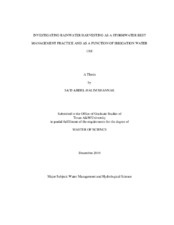| dc.contributor.advisor | Lesikar, Bruce J. | |
| dc.creator | Shannak, Sa'D Abdel-Halim | |
| dc.date.accessioned | 2012-02-14T22:18:38Z | |
| dc.date.accessioned | 2012-02-16T16:14:43Z | |
| dc.date.available | 2012-02-14T22:18:38Z | |
| dc.date.available | 2012-02-16T16:14:43Z | |
| dc.date.created | 2010-12 | |
| dc.date.issued | 2012-02-14 | |
| dc.date.submitted | December 2010 | |
| dc.identifier.uri | https://hdl.handle.net/1969.1/ETD-TAMU-2010-12-8840 | |
| dc.description.abstract | Stormwater runoff has negative impacts on water resources, human health and environment. In this research the effectiveness of Rain Water Harvesting (RWH) systems is examined as a stormwater Best Management Practice (BMP). Time-based, evapotranspiration-based, and soil moisture-based irrigation scheduling methods in conjunction with RWH and a control site without RWH were simulated to determine the effect of RWH as a BMP on a single-family residence scale. The effects of each irrigation scheduling method on minimizing water runoff leaving the plots and potable water input for irrigation were compared. The scenario that reflects urban development was simulated and compared to other RWH-irrigation scheduling systems by a control treatment without a RWH component. Four soil types (sand, sandy loam, loamy sand, silty clay) and four cistern sizes (208L, 416L, 624L, 833L) were evaluated in the urban development scenario.
To achieve the purpose of this study; a model was developed to simulate daily water balance for the three treatments. Irrigation volumes and water runoff were compared for four soil types and four cistern sizes. Comparisons between total volumes of water runoff were estimated by utilizing different soil types, while comparisons between total potable water used for irrigation were estimated by utilizing different irrigation scheduling methods.
This research showed that both Curve Number method and Mass-Balance method resulted in the greatest volumes of water runoff predicted for Silty Clay soil and the least volumes of water runoff predicted for Sand soil. Moreover, increasing cistern sizes resulted in reducing total water runoff and potable water used for irrigation, although not at a statistically significant level. Control treatment that does not utilize a cistern had the greatest volumes of predicted supplemental water among all soil types utilized, while Soil Moisture-based treatment on average had the least volume of predicted supplemental water. | en |
| dc.format.mimetype | application/pdf | |
| dc.language.iso | en_US | |
| dc.subject | Rainwater harvesting | en |
| dc.subject | Best Management Practices | en |
| dc.subject | Cistern | en |
| dc.subject | Irrigation | en |
| dc.subject | Soil type | en |
| dc.subject | Zoysia grass | en |
| dc.subject | Landscape | en |
| dc.subject | Stormwater | en |
| dc.subject | Runoff | en |
| dc.subject | Depletion | en |
| dc.subject | Irrigation Scheduling | en |
| dc.subject | Potable water | en |
| dc.subject | Supplemental water | en |
| dc.subject | Flood control | en |
| dc.subject | Urbanization | en |
| dc.subject | Curve Number | en |
| dc.subject | Mass Balance | en |
| dc.subject | Model | en |
| dc.subject | Effectiveness | en |
| dc.subject | Soil Moisture, Evapotranspiration | en |
| dc.subject | Time | en |
| dc.subject | Rainfall | en |
| dc.subject | Soil depth | en |
| dc.subject | Cistern size | en |
| dc.subject | Turfgrass | en |
| dc.subject | Simulation | en |
| dc.title | Investigating Rainwater Harvesting as a Stormwater Best Management Practice and as a Function of Irrigation Water Use | en |
| dc.type | Thesis | en |
| thesis.degree.department | Biological and Agricultural Engineering | en |
| thesis.degree.discipline | Water Management and Hydrological Science | en |
| thesis.degree.grantor | Texas A&M University | en |
| thesis.degree.name | Master of Science | en |
| thesis.degree.level | Masters | en |
| dc.contributor.committeeMember | Kaiser, Ronald | |
| dc.contributor.committeeMember | Jaber, Fouad | |
| dc.type.genre | thesis | en |
| dc.type.material | text | en |


